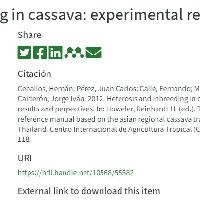Resumen
- Early work on the development of a scientific description of heterosis was conducted as early as 1776 when detailed research in tobacco quantified hybrid vigor. Many other scientists made contributions which led Darwin to conduct different experiments where heterosis would be expressed, including maize. He noted the deleterious effects of inbreeding and, interestingly, he also noted that they could be reversed by crossing the inbred strains (Goldman, 1999). Mendel also noted that the hybrids between his tall and short pea varieties were taller than the tall parent. Heterosis can therefore be observed in self-pollinated crops like pea as well as out-crossing crops such as maize. Heterosis, however, is very conspicuous in cross-pollinated crops and it is in that kind of crops (maize, sorghum, sunflower) where most of the work has been done. The foundations of the heterosis concept were built on early works in maize by E.M. East (1909; 1936) and G.H. Shull (1908; 1909). Maize is a crop that shows remarkable levels of heterosis, was a commercially important crop in the USA (when that pioneering work was conducted as well as today) and its reproductive characteristics greatly facilitates inbreeding and outbreeding in a controlled manner. Shull, who coined the word heterosis, published in 1908 and 1909 landmark articles describing the key aspects of inbreeding and outbreeding, inbreeding depression and heterosis. This chapter provides a description of the genetic basis of heterosis along with alternative breeding approaches to exploit it.
